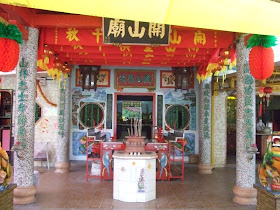The temple itself is maintained jointly by 5 Hakka clans as indicated by the sign atop the temple office:
And who was this Granduncle? A multiple-language memorial plaque clearly shows that the deity in residence is actually a trio, Zhang Li張理, Qiu Zhao-jing丘兆進, and Ma Fu-chun馬福春. They first settled in Tanjong Tokong in the mid-1700s, and were honored as 大伯公 after their death. In other words, they were the ancestors of the Hakka immigrants to Penang. This is actually a clan memorial, rather than a Taoist, temple.
In contrast, the 大伯公 in the 開山王大伯公廟 is the Earth/Village God, known in Taiwan and China as 土地公, with a formal title of 福德正神. The banners inside the temple clearly indicates the true identity:
Combining the four characters from top down in the two banners, it reads: 開山王廟福德正神. The obvious conclusion is that this 大伯公 was not an ancestor as the others in Penang, but a more traditional 土地公. Normally, an earth god, only a minor deity, cannot share the same altar with a king. Why was the exception in the Jelutong temple?
Here the story gets a bit complicated and is in part somewhat supernatural.
In ca 1910-20, some businessman "from the north (probably Siam)", asked to "borrow" the Koxinga statue to be honored in wherever he came from. This was a common practice at that time. Not suspecting any malicious intents, the Jelutong temple overseers had generously agreed. And that was the last time they saw the statue. Since a temple cannot be without a deity, in semi-panic, the idea of inviting a 大伯公 in, emerged. And since there was no appropriate ancestors to choose from because Koxinga was the one, the earth god would have to be a stand-in. For the next several decades, the temple became known as the Koxinga-earth god temple. That is until 1991 when Koxinga, through a spiritual medium, had "asked" to return to the temple. And the followers immediately complied. His Highness had very specific description of a statue plus another of NaZa, both to be commissioned and fashioned in Hokkien, China. And amidst great fanfare, Koxinga finally came back to Jelutong.










